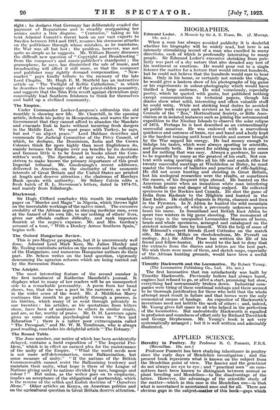BIOGRAPHIES.
Edmund Loder. A Memoir by Sir A. E. Pease, Bt. (J. Murray. 18s. net.)
When a man has always avoided publicity it is doubtful whether his biography will be widely read, but here is an intensely stimulating record of a man who excelled in many directions, each of 'which is profoundly interesting to many people. Sir Edmund Loder's excessive shrinking from pub- licity was part of a shy nature that also dreaded any test of his sentiment or emotions. He would pour out to a single listener the matter for a lecture that would interest hundreds, but he could not believe that the hundreds would care to hear him. Only in his home, or certainly not outside the village, be would give a lantern show of his photographs of big game or his experiments in colour-photography which would have thrilled a large audience. He read voraciously, especially poetry, which he quoted with gusto, but published nothing except communications to technical papers, though his diaries show what solid, interesting and often valuable stuff he could write. While not shirking local duties he avoided all public work except such services as he could give on the Councils of the "too," Horticultural Society, or Rifle Asso- ciation or in isolated instances such as joining the astronomical expedition to the Nicobar Islands to observe the solar eclipse of 1875. Perhaps he is best described as an extraordinarily successful amateur. He was endowed with a marvellous quickness and sureness of brain, eye and hand and a body kept in the hardest training until heart trouble and sorrow brought by the War sapped his energy. He had money enough to indulge his tastes which were always sporting or scientific, and generally both. He cared for nothing mean in any sense and for nothing that was easy. Always a gardener, he came to be regarded by many as the greatest of his craft. Not con tent with using sporting rifles all his life and match rifles for twenty successful meetmgs at Wimbledon or Bisley, he must master the theories of ballistics and practice of rifle-building. He did not scorn hunting and shooting in Great Britain, but his zoological researches were the results, or sometimes the causes, of his frequent trips abroad. He hunted on the American prairie when an incautious white man interfering with buffalo ran real danger of being scalped. He collected specimens in the Rockies and Canada. He shot the game of India from Kashmir to the Nilghiris and hunted in the East Indies. He stalked chamois in Styria, chamois and ibex in the Pyrenees. In N. Africa he hunted the wild mountain sheep and gazelles, of which a previously unknown species bears his name. In Somaliland and British East Africa he spent two winters in big game shooting. The monument of these trips is the unequalled Leonardslee Museum of horns, heads and whole specimens, arranged and catalogued on the strictest scientific lines by himself. With the help of some of Sir Edmund's expert friends (Lord Cottesloe on the match rifle, Mr. John Millais on rhododendrons, Mr. Pycraft on zoology, &c.) Sir Alfred Pease has written the life of his friend and fellow-hunter. He would be the last to deny that the extracts from the diaries and letters are the best part. We wish there were more of them, and sketch maps, especially of the African bunting grounds, would have been a useful addition.














































 Previous page
Previous page